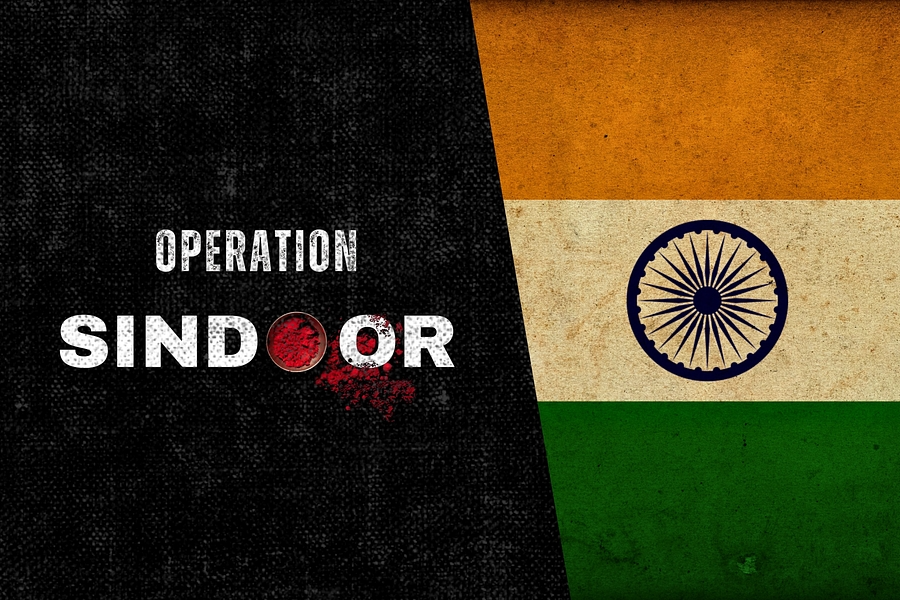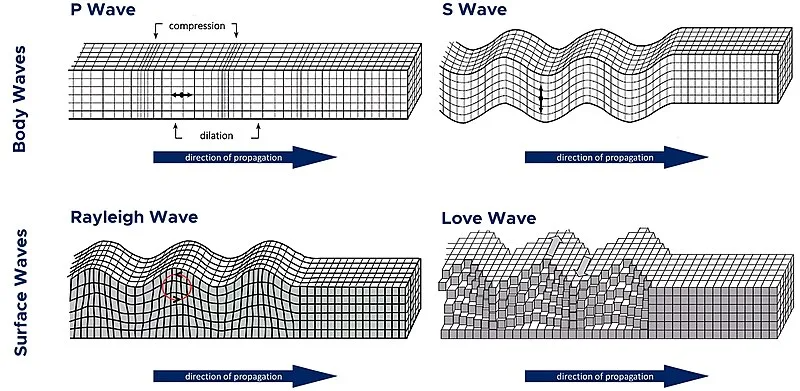September 11th Current Affairs
Table of Contents
NIOS History Textbooks
NIOS History Textbooks NIOS History Secondary NIOS History Senior Secondary
NCERT Sociology Textbooks
NCERT Sociology Textbooks NCERT Sociology for Class-XI (Introducing Sociology) NCERT Sociology for Class-XI (Understanding Society) NCERT Sociology for Class-XII (Indian
NCERT Economy Textbooks
NCERT Economy Textbooks NCERT Economy for Class-IX (Economics) NCERT Economy for Class-X (Understanding Economic Development) NCERT Economy for Class-XI (Indian
NCERT Polity Textbooks
NCERT Polity Textbooks NCERT Polity for Class-VI (Social Science – Social And Political Life – I) NCERT Polity for Class-VII
NCERT Indian Art and Culture Textbooks
NCERT Art and Culture Textbooks NCERT Art and Culture for Class-XI (An Introduction to Indian Art – Part-1) NCERT Art
NCERT Geography Textbooks
NCERT Geography Textbooks NCERT Geography for Class-VI (Social Science – The Earth Our Habitat) NCERT Geography for Class-VII (Social Science
NCERT History Textbooks
NCERT History Textbooks NCERT History for Class-VI (Social Science – Our Pasts-I) NCERT History for Class-VII (Social Science – Social
Kannada Literature Optional Syllabus
Home / ಐಚ್ಚಿಕ ಕನ್ನಡ ಸಾಹಿತ್ಯದ ಪಠ್ಯಕ್ರಮ ಐಚ್ಚಿಕ ಕನ್ನಡ ಸಾಹಿತ್ಯ ಪತ್ರಿಕೆ – 1 ವಿಭಾಗ – ಎ ಅ) ಕನ್ನಡ ಭಾಷೆಯ ಚರಿತ್ರೆ ಭಾಷೆ
UPSC Current Affairs – October 6th
October 06th Current Affairs Home / Table of Contents 36-hour curfew imposed in parts of Odisha’s Cuttack over communal tensions
Religious Minorities in India and the Challenge of Communal Harmony: A Sociological Reflection on the Cuttack Violence
Home / Religious Minorities in India and the Challenge of Communal Harmony: A Sociological Reflection on the Cuttack Violence Sociology
Oracle’s Larry Ellison topples Elon Musk to become the richest man in the world for the first time

Relevance to UPSC
- Economy & Finance (GS III): Illustrates how corporate earnings, stock market performance, and share valuation directly influence personal wealth and wealth concentration.
- Technology & Innovation (GS III): Highlighting Ellison’s leadership at Oracle, AI infrastructure investments (like supplying electricity for AI operations), crucial in understanding tech-led growth.
More About the News
- Larry Ellison’s net worth surged to US$393 billion, surpassing Elon Musk’s US$385 billion, marking Ellison’s entry into the topmost richest position.
- Oracle’s stock jumped by 41% in a single trading session, following quarterly earnings that beat expectations; shares are up ~45% year-to-date.
- Major contracts: Oracle secured multibillion-dollar deals and committed to supplying large-scale electricity to power AI operations of OpenAI
Income Inequality
Income inequality refers to the uneven distribution of income across individuals or groups within an economy. It is both a developmental and governance challenge, affecting social justice, growth, and stability. In India, despite high growth, the top 1% owns a disproportionate share of wealth, highlighting structural imbalances.
Key Trends
Global:
- Top 1% owns nearly half of global wealth; Oxfam (2024) reports stark gaps between billionaires and working poor.
- Rising inequality in advanced economies despite welfare systems, partly due to automation and capital concentration.
India:
- Top 1% holds over 40% of wealth, while bottom 50% share less than 10% (Oxfam, 2023).
- Rural-urban divide and informal sector dominance exacerbate income disparities.
Constitutional & Non-Constitutional Provisions to tackle Income Inequality:
Constitutional:
- Article 14 – Equality before law.
- Article 38 – Promote welfare of people and reduce inequalities.
- Article 39(c) – Prevent concentration of wealth.
- Article 46 – Promote educational and economic interests of weaker sections.
Non-Constitutional:
- NITI Aayog’s inequality reports.
- National Human Rights Commission’s focus on socio-economic rights.
- Economic surveys highlighting growth vs. inequality balance.
Features of Income Inequality
- Persistent across regions, caste, gender, and class.
- Often linked to asset ownership (land, capital, digital access).
- Dynamic – grows faster during high-growth phases without redistributive policies.
- Intergenerational – wealth passes down, reinforcing inequality.
Methods & Economic Techniques to Measure Inequality
- Gini Coefficient (0 = perfect equality, 1 = maximum inequality).
- Lorenz Curve (graphical measure of income distribution).
- Palma Ratio (income share of top 10% vs. bottom 40%).
- Theil Index / Atkinson Index (statistical inequality measures).
- Kuznets Curve (development vs. inequality hypothesis).
Impacts of Income Inequality
- Economic Growth slowdown – Unequal consumption hampers demand (e.g., India’s rural demand stagnation despite GDP growth).
- Social unrest – Protests like “Occupy Wall Street” highlight discontent.
- Political capture – Wealthy elites influence policy (e.g., corporate lobbying in US, crony capitalism in India).
- Health & Education gaps – Poorer groups lack access, fueling poverty cycle (e.g., malnutrition in tribal areas of India).
- Gender inequality – Wage disparity worsens women’s empowerment (e.g., India’s female labour force participation under 25%).
Challenges in Containing Inequality
- Informal economy dominance – 80% of India’s workforce lacks social security.
- Taxation limitations – Low direct tax base, overreliance on regressive indirect taxes (e.g., GST burden on poor).
- Regional imbalances – BIMARU states lag behind, worsening inequality.
- Digital divide – Unequal access to digital skills in AI economy.
- Policy capture & leakages – Subsidies/benefits often cornered by middlemen (e.g., PDS leakages before DBT reforms).
Government Initiatives
- MGNREGA – Wage security for rural poor.
- National Food Security Act – Ensuring affordable food.
- PM-KISAN – Direct transfers to farmers.
- Jan Dhan Yojana – Financial inclusion drive.
- GST reform + DBT – Reducing leakages.
Best Practices
Global:
- Nordic Model (Sweden, Norway) – High taxation, universal welfare, inclusive growth.
- Brazil’s Bolsa Família – Conditional cash transfer reducing poverty gaps.
India:
- Kerala Model – High human development despite modest income.
- Aadhaar-enabled DBT – Direct transfers reducing leakages and targeting poor.
Way Forward
- Progressive taxation with wealth and inheritance tax.
- Strengthening public health and education.
- Bridging digital divide with skill development.
- Regional balancing through infrastructure and investment.
- Promoting inclusive innovation for bottom-of-pyramid populations.
Income inequality, if unchecked, can undermine democracy, growth, and social harmony. India must adopt inclusive growth models by strengthening redistribution, improving human capital, and ensuring digital inclusion. Future development must align prosperity with equity to sustain social stability.
Prelims MCQ
Q. Which of the following statements regarding income inequality are correct? 1. The Lorenz Curve always lies above the line of perfect equality. 2. The Gini Coefficient ranges between 0 and 1. 3. Palma Ratio compares the income share of top 10% to the bottom 40%. 4. Kuznets Curve suggests inequality first rises and then falls with economic growth.
A. 1 and 2 only
B. 2, 3 and 4 only
C. 1, 3 and 4 only
D. 1, 2, 3 and 4
Mains Question
Q. “Rising income inequality poses a challenge to India’s vision of inclusive growth.” Critically analyze with global comparisons and suggest policy measures.
French Safran and DRDO combine to give India its first jet engine
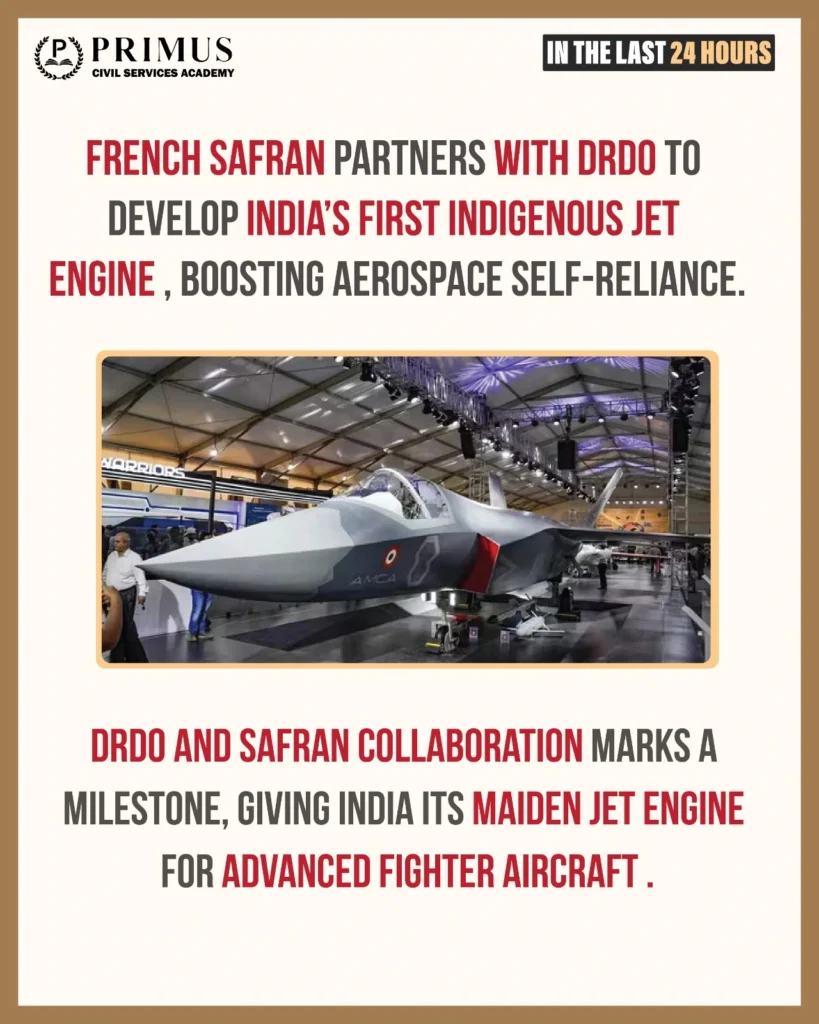
Relevance to UPSC
- GS III — Defence and Security / Science & Technology: This development strengthens India’s aerospace & defence self-reliance by developing its own jet engine technology.
- GS II — International Relations: Partnership with France (Safran) underscores strategic partnerships, technology transfer, and non-dependence on hostile or uncertain vendors.
- GS III / GS II — Economic Growth & Strategic Autonomy: Indigenous development reduces import dependence, saves foreign exchange, and enhances India’s capability to project power and build high-technology defence products.
More About the News
- Safran (France) and DRDO’s Gas Turbine Research Establishment (GTRE) plan to co-develop a 120-140 kilo Newton (KN) jet engine, which would power the Advanced Medium Combat Aircraft (AMCA).
- Safran will transfer 100% of the technology to DRDO including critical “crystal blade” technology.
- Nine prototypes of the jet engine are to be developed over a period of 12 years.
Defence Research & Development Organisation (DRDO)
The Defence Research & Development Organisation (DRDO), established in 1958, is India’s premier defence R&D agency. It plays a pivotal role in developing indigenous technologies to reduce dependence on imports, strengthen national security, and promote self-reliance under the Atmanirbhar Bharat Abhiyan.
Evolution
- 1958: DRDO formed by merging Technical Development Establishment (TDEs) of the Indian Army and Defence Science Organisation (DSO).
- 1970s–80s: Expanded into missile and electronics systems.
- 1983: Launch of Integrated Guided Missile Development Programme (IGMDP) under Dr. A.P.J. Abdul Kalam.
- 1998–2000s: Breakthroughs in Agni, Prithvi missiles, nuclear submarine tech.
- 2014 onwards: Boost under Make in India and Defence Indigenisation Policy.
Statutory Provisions
Functions under Ministry of Defence (MoD), not a statutory body but guided by:
- Allocation of Business Rules, 1961 – assigns DRDO’s role under MoD.
- Defence Procurement Procedure (DPP) & Defence Acquisition Procedure (DAP 2020) – promote indigenous R&D.
- Patents Act, 1970 – protects innovations.
- Linked with constitutional provisions like Article 51A (h) – promoting scientific temper.
Role and Functions
- Developing defence systems (missiles, aircraft, UAVs, radars, tanks).
- Supporting armed forces with cutting-edge technologies.
- Promoting self-reliance in critical defence technologies.
- Collaborating with global partners for joint R&D.
- Providing dual-use technologies (healthcare, disaster management, AI).
Impacts of DRDO in Policy Making
- Strategic Autonomy – Indigenous missile development under IGMDP reduced reliance on imports (e.g., Agni, Prithvi).
- Defence Procurement Policy – Influenced indigenisation clauses in DAP 2020 (e.g., Light Combat Aircraft – Tejas).
- Nuclear Doctrine – Critical inputs in delivery systems for India’s nuclear triad (e.g., Arihant submarine project).
- Civil Sector Spin-offs – Life sciences R&D influenced health policies (e.g., DRDO-developed PPE during COVID-19).
- International Defence Cooperation – Shaped India’s export push (e.g., BrahMos exports with Russia).
Best Initiatives of DRDO
- Missiles: Agni, Prithvi, Akash, Nag, BrahMos.
- Aircraft: LCA Tejas, AEW&C “Netra”.
- Naval Systems: Arihant-class nuclear submarine tech, torpedoes.
- Space & Cyber: ASAT weapon tested in 2019.
- Life Sciences: COVID ventilators, PPE kits, bio-toilets.
Role of DRDO in Crucial Military Confrontations
- Kargil War (1999): Supplied UAVs, snow clothing, surveillance systems.
- Post-26/11 era: Accelerated electronic surveillance systems and radars.
- Balakot (2019): Precision-guided munitions developed by DRDO supported IAF.
- China Standoff (2020): Quick deployment of UAVs, portable oxygen plants, and border infrastructure tech.
Challenges of DRDO
- Delays in Projects – Tejas aircraft development spanned decades.
- Cost Overruns – Arjun tank project exceeded initial budgets.
- Dependence on Foreign Tech – Jet engines still reliant on imports (e.g., Kaveri engine project failure).
- Limited Industry Collaboration – Weak private sector participation delays scaling.
- Export Competitiveness – India lags in global defence exports despite large R&D (contrast with Israel, South Korea).
Government Initiatives
- Atmanirbhar Bharat in Defence – Import bans on over 400 items to promote DRDO technologies.
- Defence Acquisition Procedure 2020 – Emphasises indigenous design and development.
- iDEX (Innovations for Defence Excellence) – Connects startups with DRDO projects.
- Defence Corridors in UP & TN – Promote industry linkage with DRDO.
- Boost to Defence Exports Policy (2020) – Encourages global collaboration.
Best Practices
Global:
- Israel’s Rafael Advanced Systems – Close industry–defence R&D collaboration.
- DARPA (USA) – Dual-use innovation in AI, drones, internet technologies.
India:
- BrahMos JV with Russia – Successful international collaboration.
- DRDO–ISRO synergy – Shared technologies in propulsion, cryogenics.
Way Forward
- Strengthen DRDO–private industry linkages for faster productisation.
- Introduce independent project audits to curb delays.
- Promote global partnerships in niche areas like AI, space defence, quantum tech.
- Attract global talent and retain Indian scientists with incentives.
- Enhance export focus with DRDO-led “Make in India, Sell to World” vision.
DRDO has been the backbone of India’s defence self-reliance journey. While delays and technological gaps remain, its role in shaping strategic autonomy is undeniable. Moving forward, integrating DRDO with private industry and global collaborations will determine India’s rise as a defence technology powerhouse.
Prelims MCQ
Q. With reference to DRDO, consider the following statements: 1. DRDO was established in 1958 under the Ministry of Defence. 2. The Integrated Guided Missile Development Programme (IGMDP) was launched under DRDO in 1983. 3. DRDO directly reports to the Prime Minister’s Office (PMO).
A. 1 and 2 only
B. 2 and 3 only
C. 1 and 3 only
D. 1, 2 and 3
Mains Question
Q. “Evaluate the role of DRDO in India’s journey towards defence self-reliance. Discuss its achievements, challenges, and the reforms required to enhance its effectiveness.”
After Sharjeel Imam, Umar Khalid seeks top court relief in 2020 Delhi riots case
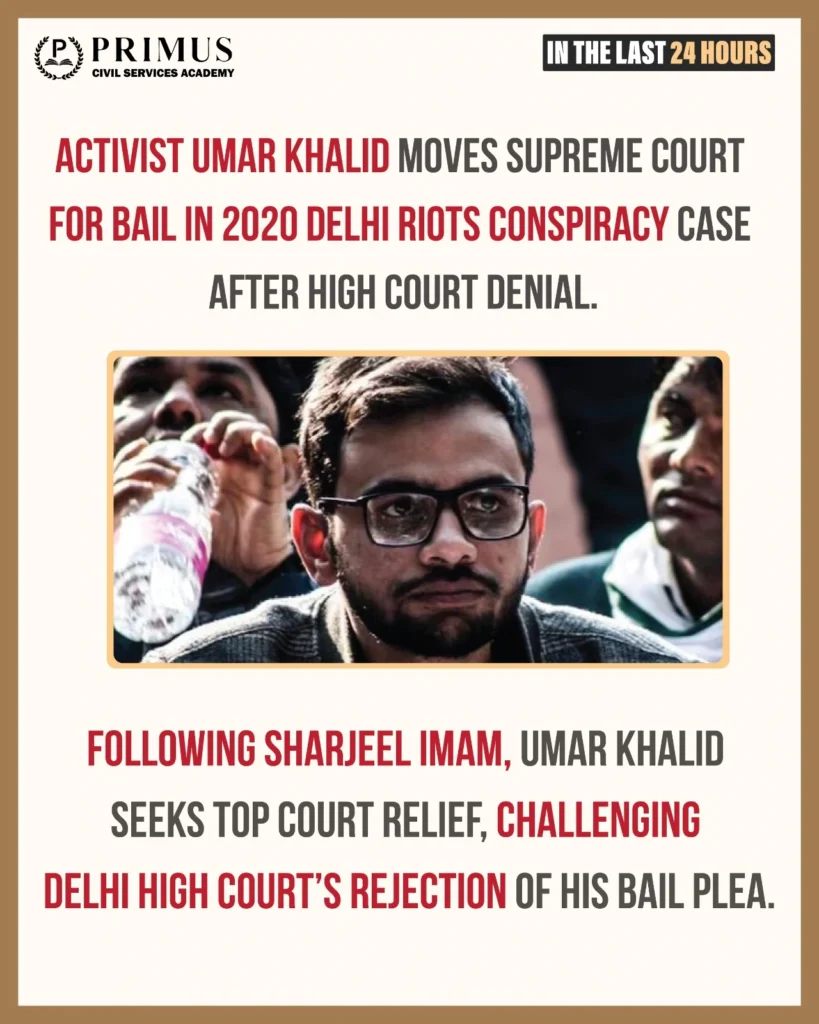
Relevance to UPSC
- GS II — Polity & Constitution: Raises questions about bail law, right to fair trial, delay in justice, and balancing individual liberty vs public order.
- GS II / GS I — Human Rights & Rule of Law: Issues of prolonged incarceration, presumption of innocence, and legal safeguards under UAPA.
More About the News
- Umar Khalid has approached the Supreme Court seeking bail in the larger conspiracy case related to the 2020 northeast Delhi riots, challenging the Delhi High Court’s earlier refusal.
- The Delhi High Court had denied bail to Umar Khalid, Sharjeel Imam, and several others, holding that delay or long incarceration alone are not sufficient grounds for bail.
- The riots are alleged to be a “larger conspiracy” under the UAPA, with Khalid accused of being among the “masterminds”; he has been in custody since his arrest in September 2020.
Unlawful Activities (Prevention) Act, 1967 (UAPA)
The Unlawful Activities (Prevention) Act (UAPA), enacted in 1967, is India’s primary anti-terror legislation aimed at preventing unlawful activities threatening the sovereignty and integrity of the nation. It has evolved over decades to tackle modern terrorism and organised insurgency. Balancing national security with civil liberties remains a key challenge for policymakers.
Evolution
- 1967: UAPA enacted to deal with secessionist activities threatening India’s unity.
- 2004: Amendment introduced stricter penalties and expanded definitions to include terrorist activities.
- 2008 & 2012: Further amendments in response to 2008 Mumbai attacks, included provisions for terrorist organisations and financial terrorism.
- 2019: Amendment allowed designation of individuals as terrorists, not just organisations, to prevent financing or aiding terrorism.
Features & Major Highlights
- Defines “unlawful activity” and “terrorist act” comprehensively.
- Allows prohibition of organisations involved in terrorism.
- Permits confiscation of property used for terrorism.
- Provides for prolonged detention (up to 180 days with approval) without bail in certain cases.
- Central government empowered to ban organisations and declare individuals as terrorists.
Advantages
- Strengthened National Security – Prevents terrorist financing and activities (e.g., banning SIMI).
- Quick Action Against Threats – Authorities can freeze assets and detain suspects (e.g., 2008 Mumbai attack suspects).
- International Compliance – Aligns India with FATF recommendations against terrorism financing.
- Deterrence Against Organised Crime – Targets organised networks supporting terror (e.g., ISIS-linked recruitment cases).
- Protection of Sovereignty – Seeks to curb secessionist movements (e.g., banning Khalistan-supporting groups).
Disadvantages
- Potential for Misuse – Individuals accused may be detained without trial (e.g., activists like Umar Khalid).
- Erosion of Civil Liberties – Limits right to bail and prolongs detention.
- Judicial Backlog – Complex procedures delay trial.
- Vague Definitions – Terms like “unlawful activity” can be interpreted broadly.
- Political Misuse Risk – Allegations of targeting dissent or minority groups.
Impacts
- Enhanced Terrorism Control – Banned organisations like Lashkar-e-Taiba, reducing operational capacity.
- Policy Formulation – Influences national counter-terror strategy and internal security planning.
- Judicial Precedents – Supreme Court and High Courts interpret limits of preventive detention.
- International Standing – Helps India comply with global anti-terror norms, improving FATF ratings.
- Law Enforcement Empowerment – Enables coordinated operations against domestic and transnational terror networks.
Challenges
- Balancing Security and Liberty – Arrests without bail may conflict with Article 21 rights.
- Evidentiary Challenges – Collecting admissible proof in terror financing cases is complex.
- International Criticism – Allegations of human rights violations in UAPA cases.
- Overlapping Laws – Confusion with NIA Act, IPC sections on terrorism.
- Resource Constraints – Law enforcement lacks training for sophisticated financial terror tracking.
Best Practices
- USA – Patriot Act: Combines preventive detention with judicial oversight for counter-terrorism.
- UK – Terrorism Act 2000: Comprehensive ban on terror organisations, balanced with periodic review of detention.
Way Forward
- Introduce judicial review and time-bound trials to prevent misuse.
- Clarify definitions to prevent arbitrary application.
- Enhance transparency and oversight mechanisms.
- Strengthen coordination between NIA, police, and financial regulators.
- Promote community engagement to reduce radicalisation.
UAPA is a vital instrument for India’s counter-terrorism framework, balancing sovereignty and security. Future reforms must ensure protection of civil liberties while maintaining robust measures against terrorism. Strengthening oversight and judicial safeguards can make it an effective yet rights-respecting law.
Prelims MCQ
Q. With reference to the Unlawful Activities (Prevention) Act (UAPA), consider the following statements:
1. UAPA allows the government to designate individuals as terrorists.
2. UAPA was enacted in 1987 primarily to address insurgency in the North-East.
3. The Act permits preventive detention of up to 180 days without bail in certain cases.
A. 1 and 3 only
B. 2 and 3 only
C. 1 and 2 only
D. 1, 2 and 3
UAPA was enacted in 1967, not 1987. Statements 1 and 3 correctly describe the 2019 amendments and detention provisions.
Mains Question
Q. “Critically examine the Unlawful Activities (Prevention) Act in India. Discuss its effectiveness, challenges, and the balance between national security and individual liberties.”
Chronic disease deaths decline globally; India sees an increase, says Lancet study
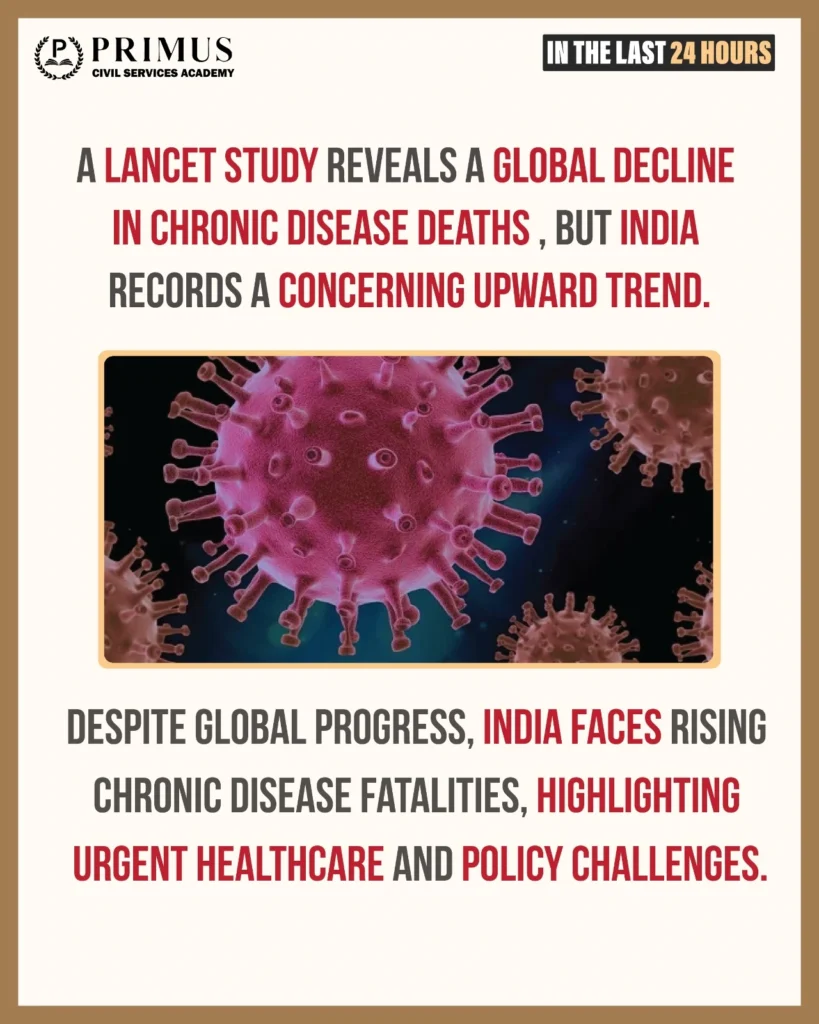
Relevance to UPSC
- GS II – Health & Policy: Highlights public health challenges and policy gaps in addressing chronic diseases in India.
- GS II – Governance: Reflects on the effectiveness of health governance and the need for systemic reforms.
More about the News
- Global Trends: The Lancet study indicates that while chronic disease death rates have declined globally, the pace has slowed in recent years.
- India’s Situation: Contrarily, India has experienced an increase in mortality from chronic diseases like cancer, heart disease, and stroke.
- Study Scope: The analysis covered data from 185 countries, focusing on the decade leading up to the COVID-19 pandemic.
Chronic Diseases
Chronic diseases, also known as non-communicable diseases (NCDs), are long-duration illnesses that progress slowly over time, such as diabetes, cardiovascular diseases, and cancer. They are now the leading cause of death globally, and India is experiencing a rising burden, challenging healthcare systems. Future strategies must focus on prevention, early diagnosis, and sustainable management.
Evolution
- Pre-20th century: Infectious diseases were the leading cause of mortality.
- Mid-20th century: Lifestyle changes, urbanization, and improved sanitation reduced communicable diseases, increasing prevalence of chronic illnesses.
- 21st century: Chronic diseases now account for over 70% of global deaths; India faces rising NCD-related mortality.
Key Trends Observed
- Global decline in chronic disease deaths in some developed countries, but rates rising in low- and middle-income nations.
- India shows an increasing trend, especially in cardiovascular diseases, diabetes, and chronic respiratory diseases.
- Urban populations have higher prevalence due to sedentary lifestyle, stress, and dietary patterns.
Features of Chronic Diseases
- Long duration and slow progression.
- Usually non-infectious.
- Require long-term medical attention and lifestyle management.
- Often preventable through risk factor management.
Symptoms of Chronic Diseases
- Persistent fatigue and weakness.
- Shortness of breath or irregular heartbeat.
- Unexplained weight loss or gain.
- Chronic pain or inflammation.
- Elevated blood sugar, cholesterol, or blood pressure.
Impacts of Chronic Diseases
- Economic Burden – High treatment costs reduce household savings (e.g., diabetes treatment in India costing ~₹30,000/year).
- Productivity Loss – Chronic illnesses reduce work capacity (e.g., hypertension and heart disease cause absenteeism).
- Healthcare System Strain – Overload of hospitals and clinics (e.g., India’s tertiary hospitals seeing high cardiovascular patient influx).
- Social Impact – Disability and reduced quality of life (e.g., stroke survivors require long-term care).
- Mortality Risk – Leading cause of premature deaths (e.g., cardiovascular disease causing ~28% of deaths in India).
Challenges in Containing Chronic Diseases
- Lifestyle Factors – Sedentary habits and unhealthy diets (e.g., rising obesity rates in urban India).
- Lack of Awareness – Late diagnosis due to poor health literacy.
- Limited Healthcare Access – Rural populations often lack preventive care facilities.
- High Cost of Treatment – Expensive medications and hospitalizations limit adherence.
- Tobacco & Alcohol Use – Major risk factors for NCDs (e.g., lung cancer from smoking).
Government Initiatives
- National Programme for Prevention and Control of Cancer, Diabetes, CVDs & Stroke (NPCDCS)
- Ayushman Bharat – Health and Wellness Centres for NCD screening.
- Tobacco Control Policies under COTPA (2003) and MPOWER guidelines.
- Nutrition and Physical Activity Campaigns (Fit India Movement).
Best Practices
Global:
- WHO’s Global Action Plan on NCDs (2013–2020) – Framework for prevention, risk reduction, and monitoring.
- Finland’s North Karelia Project – Community-based interventions reduced cardiovascular disease mortality.
India:
- Kerala’s NCD Control Program – Focus on early screening and health education.
- Punjab’s Heart Disease Awareness Program – Community interventions and lifestyle modifications.
Way Forward
- Strengthen primary healthcare for prevention and early diagnosis.
- Promote healthy lifestyles through urban planning and awareness campaigns.
- Integrate digital health and AI for monitoring and management.
- Implement taxation and regulation on tobacco, sugar, and alcohol.
- Encourage public-private partnerships for NCD care and research.
Chronic diseases are a growing challenge to India’s public health, economy, and social fabric. Strategic interventions emphasizing prevention, early diagnosis, and lifestyle modifications are essential. Future health policies must balance clinical management with community-level awareness for sustainable NCD control.
Prelims MCQ
Q. With reference to chronic diseases, consider the following statements:
1. Chronic diseases are generally infectious in nature.
2. Lifestyle factors like sedentary habits and poor diet contribute to chronic diseases.
3. WHO’s Global Action Plan provides a framework for prevention and control of NCDs.
?
A. 1 and 2 only
B. 2 and 3 only
C. 1 and 3 only
D. 1, 2 and 3
Chronic diseases are non-infectious, and statements 2 and 3 correctly describe risk factors and global prevention frameworks.
Mains Question
Q. “Examine the rising burden of chronic diseases in India. Discuss its socio-economic impacts and suggest effective policy measures for prevention and management.”
NATO scrambles Jets to shoot down Russian Drones in Poland, raising concerns of War Spillover
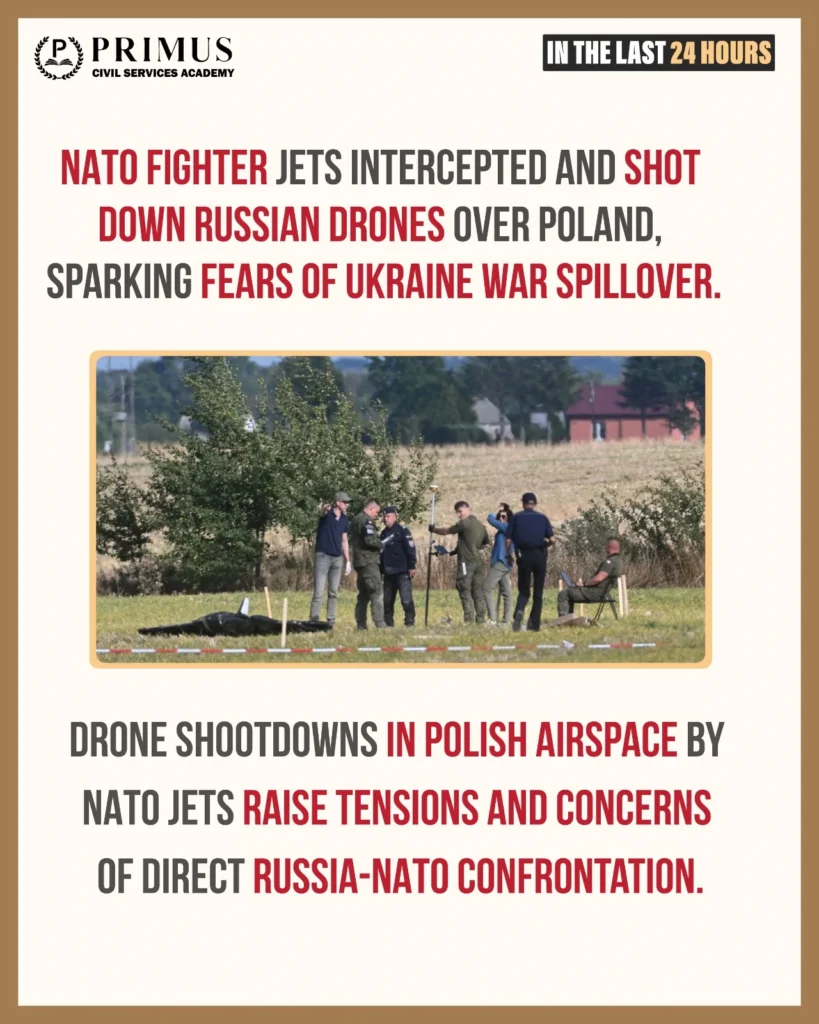
Relevance to UPSC
- GS 2 – International Relations: Highlights NATO’s collective defense mechanisms and the geopolitical dynamics between NATO and Russia.
- GS 2 – Governance: Demonstrates the invocation of NATO’s Article 4, emphasizing the alliance’s consultative process in response to security threats.
- GS 3 – Security: Illustrates the evolving nature of warfare, including the use of drones and hybrid tactics in modern conflicts.
More about the News
- Incident Overview: On September 10, 2025, multiple Russian drones entered Polish airspace, prompting NATO to scramble jets to intercept and shoot them down.
- NATO’s Response: This marked the first time NATO confronted a potential threat within its airspace, highlighting the alliance’s commitment to collective defense.
- Article 4 Invocation: Poland invoked NATO’s Article 4, initiating consultations among member states to address the perceived threat to its territorial integrity.
North Atlantic Treaty Organisation (NATO)
The North Atlantic Treaty Organisation (NATO) is a military alliance established in 1949 to ensure collective defense against external aggression. It has evolved to address global security challenges beyond Europe, including terrorism, cyber threats, and hybrid warfare. For India, NATO’s actions influence geopolitical dynamics, trade, and security considerations.
Evolution
- 1949: NATO established with the signing of the North Atlantic Treaty in Washington D.C. by 12 founding members.
- Cold War Era: Primarily aimed to contain Soviet expansion in Europe.
- Post-1991: Shifted focus to crisis management, peacekeeping, and counter-terrorism.
- 21st Century: Expanded to 31 members (as of 2025) and adopted collective cyber and hybrid warfare defense strategies.
- Recent Developments: Active in Ukraine crisis, NATO-Russia tensions, and hybrid warfare deterrence.
Key Trends Observed
- Expansion eastward into former Warsaw Pact countries.
- Increased focus on cyber defense, drones, and AI-enabled warfare.
- Active role in global peacekeeping, counterterrorism, and strategic deterrence.
- Strengthening collective defense through joint exercises and intelligence sharing.
Features
- Collective Defense: Article 5 commits members to defend one another.
- Consultative Mechanism: Article 4 allows members to consult in case of threats.
- Integrated Military Command: Joint military structures and standardization of forces.
- Political Alliance: Promotes democratic governance and stability among members.
- Global Outreach: Partnerships with non-member states for cooperative security.
Members of NATO
- 31 members including the USA, UK, France, Germany, Canada, Poland, Spain, Italy, Turkey, and others.
- Recently, Finland joined, increasing NATO’s northern European presence.
Counter Organisations of NATO
- Warsaw Pact (Historical) – Former Soviet-led alliance dissolved in 1991.
- CSTO (Collective Security Treaty Organization) – Led by Russia, includes Central Asian states.
- Shanghai Cooperation Organisation (SCO) – Security, counterterrorism, and strategic coordination among Asian powers.
Advantages of NATO
- Collective Security – Article 5 ensures support if a member is attacked (e.g., US support for Europe during Cold War).
- Deterrence Against Aggression – Discourages Russian expansion in Eastern Europe.
- Military Modernization – Standardization and joint exercises improve member capabilities (e.g., Trident Juncture exercises).
- Global Crisis Management – Peacekeeping in Kosovo, Afghanistan, and Libya.
- Intelligence Sharing – Enhanced detection of terrorism and cyber threats.
Disadvantages of NATO
- Escalation Risk – Provocation may trigger conflicts (e.g., Ukraine crisis 2022).
- Financial Burden – Members contribute significant GDP percentage; smaller states may be strained.
- Dependence on Superpowers – Dominance of USA may limit autonomy for smaller members.
- Political Tensions – Expansion can worsen relations with Russia and China.
- Overextension – Engaging in distant conflicts may reduce focus on member security (e.g., Afghanistan).
Impacts of NATO
- European Security Stability – Reduced likelihood of interstate wars post-WWII.
- Cold War Dynamics – Shaped East-West diplomatic and military policies.
- Global Terrorism Countermeasures – Operations in Afghanistan and anti-piracy measures.
- Military Innovation – Standardization drives technological development.
- Influence on Global Alliances – Strengthens USA-Europe ties, shapes global power structures.
Challenges in Containing NATO
- Expansionism Concerns – Provokes adversaries like Russia.
- Divergent Interests of Members – Conflicting priorities among 31 nations.
- Cyber & Hybrid Threats – Hard to counter effectively.
- Resource Allocation – Burden on smaller economies.
- Internal Politics – Rise of populist governments may hinder consensus.
Role of India in NATO
- India is not a member but maintains strategic partnerships through Partnerships for Peace and joint exercises.
- Cooperates in counter-terrorism intelligence sharing and cyber-security initiatives.
- Observes NATO operations for lessons in strategic autonomy and military modernization.
Impact of NATO on India
- Influences global geopolitical stability affecting India’s trade and security policies.
- Drives India’s defense modernization to maintain strategic autonomy.
- Indirectly affects India-Russia relations due to NATO-Russia tensions.
India’s Stance on NATO
- Advocates for strategic autonomy; prefers regional security frameworks like QUAD and SCO.
- Maintains observer or partnership status without formal membership.
- Supports NATO’s counter-terrorism goals while avoiding entanglement in global conflicts.
Way Forward
- Continue strategic partnerships with NATO for knowledge and capacity building.
- Strengthen regional alliances to balance global power shifts.
- Develop self-reliant defense systems while learning from NATO operational strategies.
- Enhance cybersecurity and hybrid warfare capabilities.
- Engage in global dialogues for conflict resolution without direct military commitments.
NATO has shaped global security and deterrence mechanisms for over seven decades. For India, understanding NATO dynamics aids in strategic planning and defense preparedness. Future policies should emphasize partnerships, regional balance, and self-reliance to navigate evolving global threats.
Prelims MCQ
Q. Consider the following statements about NATO:
1. NATO was established in 1949 primarily to contain Soviet expansion in Europe.
2. Article 5 allows consultation among members in case of a threat.
3. India is a full member of NATO.
A. 1 only
B. 1 and 2 only
C. 2 and 3 only
D. 1, 2 and 3
NATO was formed in 1949 to counter Soviet threats; Article 5 is about collective defense, not consultation (that’s Article 4). India is not a member.
Mains Question
Q. “Assess the evolution, significance, and challenges of NATO in the contemporary global security architecture. Discuss its implications for India’s strategic autonomy and foreign policy.”



